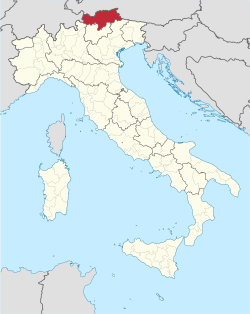
Back Suid-Tirol Afrikaans Südtirol ALS Provincia autonoma de Bozen AN جنوب تيرول Arabic جنوب تيرول ARZ Provincia autónoma de Bolzano AST Cənubi Tirol Azerbaijani Sidtiroul BAR Бальцана (правінцыя) Byelorussian Южен Тирол Bulgarian
South Tyrol
| |
|---|---|
| Autonomous Province of Bolzano – South Tyrol Autonome Provinz Bozen – Südtirol (Austrian German) Provincia autonoma di Bolzano - Alto Adige (Italian) Provinzia Autonoma de Balsan/Bulsan – Südtirol (Ladin) | |
| Anthem: Bozner Bergsteigerlied (unofficial) | |
 Map highlighting the location of the province of South Tyrol in Italy (in red) | |
| Coordinates: 46°30′0″N 11°21′0″E / 46.50000°N 11.35000°E | |
| Country | Italy |
| Region | Trentino-Alto Adige/Südtirol |
| Capital(s) | Bolzano |
| Comuni | 116 |
| Government | |
| • Body | Provincial Council |
| • Governor | Arno Kompatscher (SVP) |
| Area | |
• Total | 7,399.97 km2 (2,857.14 sq mi) |
| Population (1 January 2019) | |
• Total | 531,178 |
| • Density | 72/km2 (190/sq mi) |
| GDP | |
| • Total | €21.603 billion (2015) |
| • Per capita | €41,568 (2015) |
| Time zone | UTC+01:00 (CET) |
| • Summer (DST) | UTC+02:00 (CEST) |
| Postal code | 39XXX |
| Telephone prefix | 0471, 0472, 0473, 0474 |
| Vehicle registration | BZ |
| HDI (2022) | 0.925[2] very high 5th of 21 |
| ISTAT | 021 |
| Website | www |
South Tyrol[a] (Austrian German: Südtirol [ˈzyːttiˌʁoːl] ⓘ, locally [ˈsyːtiˌroːl]; Italian: Alto Adige [ˈalto ˈaːdidʒe]; Ladin: Südtirol) is an autonomous province in northern Italy. An English translation of the official German and Italian names could be the Autonomous Province of Bolzano – South Tyrol, reflecting the multilingualism and different naming conventions in the area. Together with Trentino, South Tyrol forms the autonomous region of Trentino-Alto Adige/Südtirol.[4] The province is the northernmost of Italy, the second largest with an area of 7,400 square kilometres (2,857 sq mi), and has a total population of about 534,000 inhabitants as of 2021.[5] Its capital and largest city is Bolzano.

The province is granted a considerable level of self-government, consisting of a large range of exclusive legislative and executive powers and a fiscal regime that allows it to retain 90% of revenue, while remaining a net contributor to the national budget. As of 2023, South Tyrol is the wealthiest province in Italy and among the wealthiest in the European Union.
In the wider context of the European Union, the province is one of the three members of the Tyrol–South Tyrol–Trentino Euroregion, which corresponds almost exactly to the historical region of Tyrol.[6] The other members are the Austrian federal state Tyrol to the north and east, and the Italian autonomous province of Trento to the south.
According to the 2024 census, 57.6% of the population used German as their first language (standard German in the written form and the South Tyrolean dialect of Austro-Bavarian in the spoken form); 22.6% of the population spoke Italian, mainly in and around the two largest cities (Bolzano and Merano); 3.7% spoke Ladin, a Rhaeto-Romance language; 16.1% of the population (mainly recent immigrants) spoke another native language in addition to Italian and German. Of 116 South Tyrolean municipalities, 102 have a German-speaking, eight a Ladin-speaking, and six an Italian-speaking majority.[7] The Italianization of South Tyrol and the settlement of Italians from the rest of Italy after 1918 significantly modified local demographics.[8][9]
- ^ Regions and Cities > Regional Statistics > Regional Economy > Regional Gross Domestic Product (Small regions TL3), OECD.Stats. Accessed on 16 November 2018.
- ^ "Sub-national HDI - Area Database - Global Data Lab". hdi.globaldatalab.org. Retrieved 5 March 2023.
- ^ "Tyrol". Random House Webster's Unabridged Dictionary.
- ^ [1] Archived 25 September 2019 at the Wayback Machine Statuto speciale per il Trentino-Alto Adige.
- ^ "Trentino-Alto Adige (Autonomous Region, Italy) - Population Statistics, Charts, Map and Location".
- ^ Cortina d'Ampezzo, Livinallongo/Buchenstein and Colle Santa Lucia, formerly parts of Tyrol, now belong to the region of Veneto.
- ^ "Statistisches Jahrbuch 2024 / statistico della Provincia di Bolzano 2024" (PDF). 03 Bevölkerung. Retrieved 23 December 2024.
- ^ Oscar Benvenuto (ed.): "South Tyrol in Figures 2008", Provincial Statistics Institute of the Autonomous Province of South Tyrol, Bozen/Bolzano 2007, p. 19, Table 11
- ^ Steininger, Rolf (2003). South Tyrol, A Minority Conflict of the Twentieth Century. Transaction Publishers. ISBN 0-7658-0800-5.
Cite error: There are <ref group=lower-alpha> tags or {{efn}} templates on this page, but the references will not show without a {{reflist|group=lower-alpha}} template or {{notelist}} template (see the help page).

